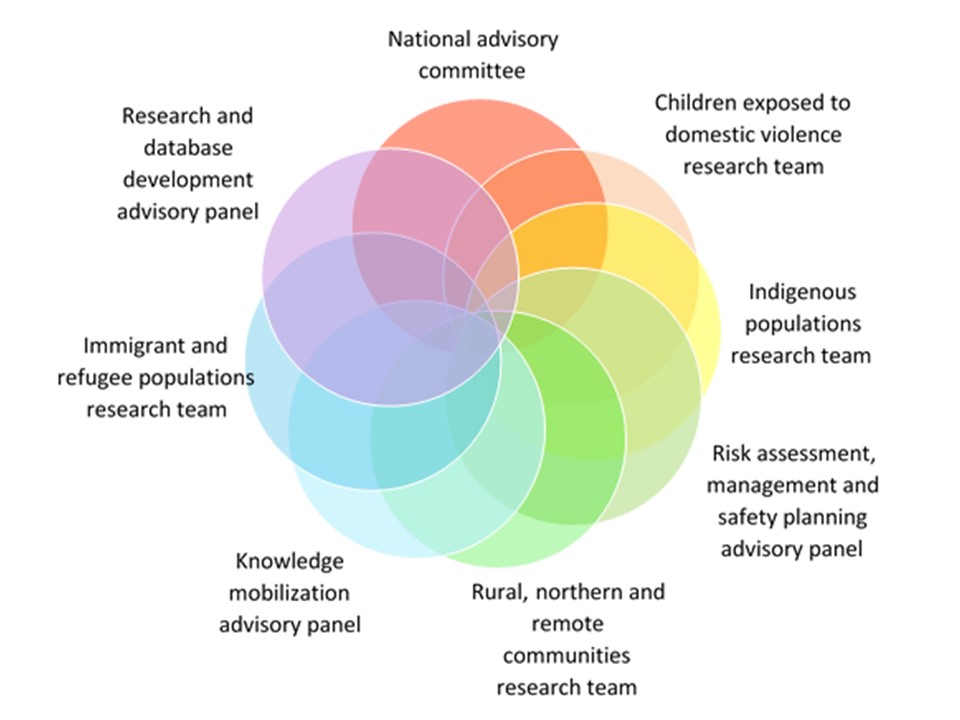The Canadian Domestic Homicide Prevention Initiative with Vulnerable Populations (CDHPIVP) is a five year project funded by the Social Sciences Humanities Research Council (SSHRC) to conduct research on domestic homicides in Canada, identify protocols and strategies that will reduce risk, and to share this knowledge with the wider community.
The goal of the Canadian Domestic Homicide Prevention Initiative with Vulnerable Populations (CDHPIVP) is to create a partnership that will foster collaborative, cross-sectoral research to identify unique individual and community-level risk factors that may increase exposure to domestic violence and homicide for particular populations. The specific outcome that will be addressed throughout the duration of the partnership will be the development of enhanced evidence-based information about effective risk assessment, risk management, and safety planning strategies to prevent lethal domestic violence for these groups and their communities.
The CDHPIVP focuses on four populations that experience increased vulnerability to domestic homicide:
-
Indigenous populations
- The rate of domestic homicide is eight times higher for Indigenous women compared to non-Indigenous women in Canada.[i]
-
Rural, remote and northern populations
- The rate of domestic homicide in rural Canada is significantly higher than in urban areas.[ii] Research identifies potential contributing factors such as seasonal employment, unemployment, role of guns.
-
Immigrant and refugee populations
- Their experiences with language, cultural and other barriers make it more difficult to report domestic violence and to access services.[iii] Existing research shows these groups face additional barriers that increase their risk such as language, discrimination/racism, economic vulnerability.
-
Children exposed to domestic violence
- Children exposed to domestic violence – children and youth who were victims of family-related violence represent 29% of all children and youth victims of violent crime.[iv] Child abuse, separation, custody and access issues identified as risk factors.
Research Priorities
- National database on domestic homicide – to serve as a central repository for data on domestic homicide cases and the identification of associated risk factors. A Protocol for the collection and storage of data has been developed. (English) (French)
- Comprehensive literature review - to systematically examine risk assessment, risk management, and safety planning strategies that currently exist for domestic violence and homicide in general and for the identified populations specifically.
- Qualitative research with stakeholders - to expand our understanding of unique risk factors associated with these vulnerable groups. Learn more about the Key Informants Survey research project at in English or in French. The second phase of this research involves interviews with people working in shelters, child protection, mental health, and justice the regarding domestic violence and homicide risk assessment, risk management and safety planning practices. A Protocol for the interview process has been developed. (English) (French)
- Multi-site control study - to compare domestic homicide cases with attempted homicide cases and cases of severe domestic violence in order to identify unique risk factors for lethality.
Partnerships and Collaboration
This research is made possible through strong local, provincial, and national partnerships that will be fostered and expanded in this initiative. The CDHPIVP team is composed of multiple academic disciplines, professions, and community settings who bring specialized domestic violence knowledge and expertise to the project.
Governance Model

For further information about the CDHPIVP, please contact:
Co-Directors:
Dr. Peter Jaffe
Academic Director, Centre for Research & Education on Violence against Women & Children (CREVAWC)
Western University
pjaffe@uwo.ca
Dr. Myrna Dawson
Director, Centre for the Study of Social and Legal Responses to Violence
University of Guelph
mdawson@uoguelph.ca
References:
[i] Statistics Canada (2006a). Victimization and offending among the Aboriginal population in Canada. Ottawa: Minister of Industry.
[ii] Northcott, M. (2011). Domestic violence in rural Canada. In S. McDonald (Ed.), Victims of Crime Research Digest (pp. 9- 14). Ottawa: DOJ.
[iii] Alaggia, R., and C. Regehr. (2009). Intimate partner violence and immigration laws in Canada: How far have we come? International Journal of Law and Psychiatry 32 (pp. 335-341).
[iv] Family Violence in Canada: A Statistical Profile, 2013 (p. 4).



